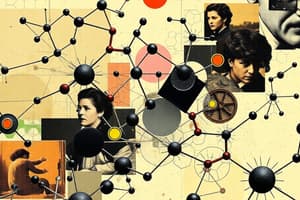Podcast
Questions and Answers
What type of reaction is used to create poly(ethene) from ethene?
What type of reaction is used to create poly(ethene) from ethene?
- Esterification
- Addition polymerisation (correct)
- Hydrolysis
- Condensation polymerisation
In addition polymerisation, the repeat unit in the polymer has a different set of atoms compared to the original monomer.
In addition polymerisation, the repeat unit in the polymer has a different set of atoms compared to the original monomer.
False (B)
What small molecule is typically lost during condensation polymerisation?
What small molecule is typically lost during condensation polymerisation?
water
Polypeptides are produced when amino acids react by condensation polymerisation, forming chains via ______ bonds.
Polypeptides are produced when amino acids react by condensation polymerisation, forming chains via ______ bonds.
Match the following naturally occurring polymers with their corresponding monomer:
Match the following naturally occurring polymers with their corresponding monomer:
Which functional groups must be present on two different monomers to produce a polyester through condensation polymerisation?
Which functional groups must be present on two different monomers to produce a polyester through condensation polymerisation?
What is the primary function of DNA?
What is the primary function of DNA?
DNA molecules typically consist of a single polymer chain arranged in a helix.
DNA molecules typically consist of a single polymer chain arranged in a helix.
Consider a condensation polymerisation reaction involving two different monomers, one with two amine groups and the other with two carboxylic acid groups. What type of polymer would result from this reaction, and what small molecule would be eliminated?
Consider a condensation polymerisation reaction involving two different monomers, one with two amine groups and the other with two carboxylic acid groups. What type of polymer would result from this reaction, and what small molecule would be eliminated?
What structural feature of alkenes allows them to undergo addition polymerisation, and why is this feature essential for the reaction?
What structural feature of alkenes allows them to undergo addition polymerisation, and why is this feature essential for the reaction?
Flashcards
Addition polymerisation
Addition polymerisation
A process where many monomers join to form a large polymer without losing any atoms.
Monomer
Monomer
A small molecule that links together to form a polymer.
Polymer
Polymer
A large chain-like molecule made from many repeating monomer units.
Repeat unit
Repeat unit
Signup and view all the flashcards
Condensation polymerisation
Condensation polymerisation
Signup and view all the flashcards
Amino acids
Amino acids
Signup and view all the flashcards
Polypeptides
Polypeptides
Signup and view all the flashcards
DNA
DNA
Signup and view all the flashcards
Nucleotides
Nucleotides
Signup and view all the flashcards
Naturally occurring polymers
Naturally occurring polymers
Signup and view all the flashcards
Study Notes
Organic Chemistry: Synthetic and Naturally Occurring Polymers
-
Addition Polymerisation: Alkenes form polymers like poly(ethene) and poly(propene) through addition polymerisation. This process joins many small molecules (monomers) to create large molecules (polymers). The repeat unit in the polymer has the same atoms as the monomer.
-
Condensation Polymerisation: Monomers with two functional groups join together, often releasing a small molecule like water. This is called condensation. Simplest polymers are formed from two different monomers with identical functional groups on each monomer. Examples include Polyesters, formed from monomers with carboxylic acid and alcohol functional groups, and polypeptides (which form proteins) from amino acids.
DNA and other Naturally Occurring Polymers
-
DNA (Deoxyribonucleic acid): A large molecule vital for life, encoding genetic instructions. It's a double helix formed from four different monomers called nucleotides.
-
Other Naturally Occurring Polymers:
- Proteins are formed from amino acid monomers.
- Starch and cellulose are formed from glucose monomers.
Studying That Suits You
Use AI to generate personalized quizzes and flashcards to suit your learning preferences.




